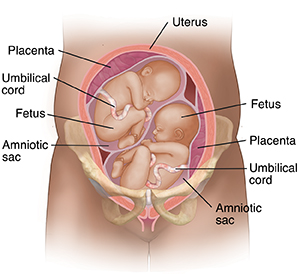Overview of Multiple Pregnancy
What is multiple pregnancy?
A multiple pregnancy is a pregnancy with 2 or more babies. Some names for these are:
-
Twins for 2 babies
-
Triplets for 3 babies
-
Quadruplets for 4 babies
-
Quintuplets for 5 babies
-
Sextuplets for 6 babies
-
Septuplets for 7 babies
Multiples make up only about 3 in 100 births, but the multiple birth rate is rising.
According to the National Center for Health Statistics, the twin birth rate has risen 70%
since 1980. It is now 32.6 per 1,000 live births. The birth rate for triplets and
other higher-order multiples rose dramatically. But it has slowed since 1998.
What causes multiple pregnancy?
Many factors are linked to having a multiple pregnancy. Naturally occurring factors
are:
-
Heredity. A family history of multiple pregnancy raises the chances of having twins.
-
Older age. People assigned female at birth who are older than 30 have a greater chance of multiple
pregnancy. Today, many people assigned female at birth are waiting to have children until
later in life. They may have twins as a result.
-
Past pregnancies. Having 1 or more previous pregnancies, especially a multiple pregnancy, raises the
chances of having multiples.
-
Race. African-American people assigned female at birth are more likely to have twins than
any other race. Asian Americans and Native Americans have the lowest rates for twins.
White people assigned female at birth have the highest rate of higher-order multiple
births (triplets or more). This is especially true for those older than 35.
Other factors that have greatly raised the multiple birth rate in recent years are
reproductive technologies, such as:
-
Ovulation-stimulating medicines. These include clomiphene citrate and follicle stimulating hormone (FSH). These help
produce many eggs. If fertilized, they can result in multiple babies.
-
Assisted reproductive technologies. In vitro fertilization (IVF) and other methods may help couples get pregnant. These
technologies often use ovulation-stimulating medicines to produce multiple eggs. These
are then fertilized in the lab and returned to the uterus to grow.
How does multiple pregnancy happen?
Multiple pregnancy often happens when 2 or more eggs are fertilized and implant in
the uterus. This is called fraternal twinning. These babies can be the same sex or
the opposite sex. Fraternal multiples are simply siblings conceived at the same time.
But just as siblings often look alike, fraternal multiples may look very similar.
Fraternal multiples each have a separate placenta and amniotic sac.

Sometimes 1 egg is fertilized and then splits into 2 or more embryos. This is called
identical twinning. When this happens, the babies are the same sex. Identical multiples
are genetically the same. They often look so much alike that even parents have a hard
time telling them apart. But these children have different personalities and are distinct
people. Identical multiples may have individual placentas and amniotic sacs. Most
share a placenta with separate sacs. In rare cases, identical twins share 1 placenta
and a single amniotic sac.